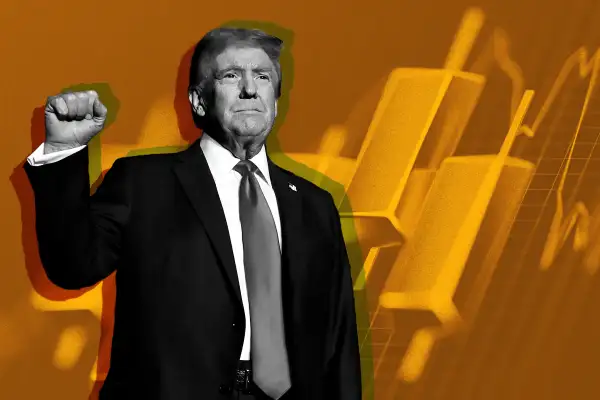Here's How President Trump Could Impact Gold Prices
Money is not a client of any investment adviser featured on this page. The information provided on this page is for educational purposes only and is not intended as investment advice. Money does not offer advisory services.

Following his victory last November, President Donald Trump's impact was immediately felt in the markets. One day after the election, the S&P 500 gained 2.53%, the Dow Jones Industrial Average gained 3.58%, and the Nasdaq Composite gained 2.93%. All three indices set all-time highs.
But gold, which hits its most recent record high in October 2024, reacted unfavorably to the U.S. choosing Trump as its 47th president, falling by 7.29% from Nov. 5 until bottoming on Nov. 15.
These are, of course, extreme short-term examples, and volatility is typically more pronounced in the short term. However, given that an estimated 85% of professional investors now own gold, it's important for Americans to be aware of how Trump's policies could impact gold prices over the long term. And with the yellow metal having rallied nearly 35% so far this year, investors should keep an eye on the precious metal, which is likely to enjoy favorable conditions under the new administration.
Inflationary tariffs could propel gold prices
Trump has been abundantly clear about his plan to enact tariffs on countries like Mexico and China. Although the president has said other countries will pay the taxes on imported goods, experts and executives alike have predicted the increased costs of those items will actually be passed on to consumers. According to the National Retail Federation, the Trump's tariff plan could cost Americans $78 billion annually.
In the lead-up to Election Day, 23 Nobel Prize-winning economists signed an open letter stating that Trump's "counterproductive economic agenda ... including high tariffs even on goods from our friends and allies and regressive tax cuts for corporations and individuals, will lead to higher prices."
Gold prices, which have historically risen alongside inflation, could be bolstered by Trump's tariffs. For example, when the Consumer Price Index began its steep ascent in August 2020, it coincided with gold's then-all-time-high price. That's because gold, which acts as a hedge against inflation, tends to see inflows as prices rise and the purchasing power of the dollar diminishes.
Looking farther back, when inflation hit 13.5% in 1980 under President Jimmy Carter, gold similarly surged to a record high that wasn't surpassed until 2006 in the wake of inflation reaching a five-year high during President George W. Bush's second term.
So while Trump's use of tariffs is likely to hurt the budgets of everyday American consumers, it could benefit precious metal investors.
Falling interest rates can help precious metal prices
Trump has said that lower interest rates are central to his goal of making housing more affordable. And although the Federal Reserve brought interest rates down by a full percentage point last fall, the president has been critical of Chairman Jerome Powell, whom he appointed.
Trump may now be eyeing a more aggressive approach. Despite not having a formal housing plan in place, Trump has said that his administration "will drive down the rates so you will be able to pay 2%."
It is worth noting that presidents do not control interest rates. However, interest rates have a historically inverse relationship with gold prices. Because gold is not a yield-producing asset, it is generally viewed as less attractive in a higher-rate environment; conversely, when rates fall and investors move away from yield-oriented assets like bonds and certificates of deposit, gold demand tends to increase, thereby driving up prices.
If Trump's intended tariffs do result in higher inflation, the pace of the Fed's interest rate cuts could slow if the central bank is forced to re-examine its monetary policy that has successfully brought down inflation from its June 2022 high of 9.1% to its current 2.9%.
Geopolitical unrest could drive prices
During his first term, Trump alienated many U.S. allies. His 2024 election victory is bringing about concerns that similar actions will be taken during his second administration.
Leslie Vinjamuri, director of the U.S. and Americas program at the think tank Chatham House, told PBS News that a second Trump White House is creating an "existential concern for Europeans," with much anxiety rooted in how the president will handle the Ukraine-Russia war and America's commitment to NATO.
Trump has repeatedly expressed that he opposes the U.S. sending aid packages to Ukraine while also praising the leadership of Russian President Vladimir Putin. He has also said that as president, he would not defend NATO allies that failed to meet his specified spending requirements, going as far as saying, "I would encourage [Russia] to do whatever the hell they want."
In the Middle East, Trump remains a fervent supporter of Israel's ongoing war with Hamas. Despite the ceasefire brokered by former President Biden in the final days of his term, Reuters reported on Sunday that Trump has instructed the U.S. military to release a hold imposed by Biden on the supply of 2,000-pound bombs to Israel.
Geopolitical unrest is a principal driver of gold prices. In the first quarter of 2022, gold gained 6% after the Russia-Ukraine war began. Similarly, when the conflict between Hamas and Israel erupted in the third quarter of 2023, the precious metal gained 8.78% in just 20 days following the attack.
As such, a defensively weakened Ukraine, severed ties with the NATO alliance and continued aid to Israel under a second Trump presidency could also positively impact gold.
More from Money:
How China Became the World's Largest Gold Consumer and Producer

